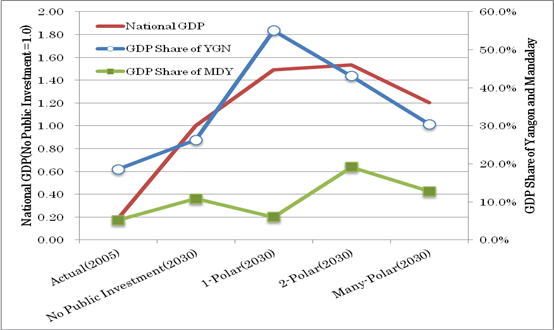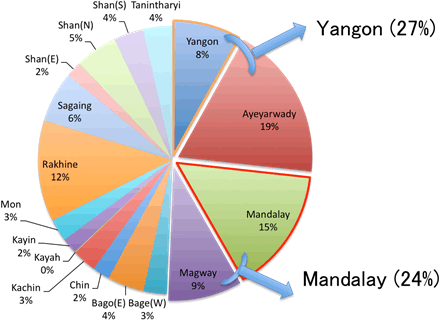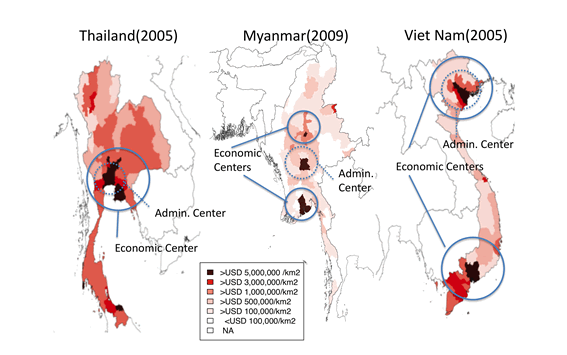Two-Polar Growth Strategy in Myanmar: Seeking “High” and “Balanced” Development
Policy Review on Myanmar Economy
No.8
Toshihiro KUDO and Satoru KUMAGAI
December 2012
PDF (200KB)
PDF (Burmese) (267KB) BUSINESS , Union of Myanmar Federation of Chambers of Commerce & Industry, Vol.13, No.2, February 2013
The Myanmar government seeks higher and balanced economic growth. This is a challenge for the government since some economic literature identifies a trade-off between higher economic growth and better regional equality, especially for countries in the early stages of development. In this paper, we propose a two-polar growth strategy that includes both “high” and “balanced” growth. The first growth pole is Yangon and the second is Mandalay. Nay Pyi Taw, the national capital, will develop as an administrative centre, not as an economic or commercial one. We also propose border development with enhanced connectivity to richer neighboring countries as a complementary strategy to the two growth poles 1 .
Growth and Regional Inequality
“Balanced regional economic growth” is an attractive policy slogan at present in a world where many countries suffer and fail to manage regional income inequality. But there is a question as to whether or not equality with higher economic
growth is feasible in the first place. There are a number of studies that examine the relationship between economic growth and regional income inequality, finding that regional income inequality is not just an adverse effect of economic growth and that the two phenomena have circular causation. Just as economic growth enhances economic agglomeration, economic agglomeration also enhances economic growth. The rationale is as follows: Inevitably, economic growth is geographically uneven because some regions have more advantages in doing business than other regions. Workers and firms tend to agglomerate in developed regions where they seek higher wages and larger markets. Thus, economic growth enhances economic agglomeration. At the same time, economic agglomeration is a source of positive externalities such as labour pooling and knowledge spillover. It makes it possible to provide physical and institutional infrastructures efficiently with limited resources. Therefore, economic agglomeration enhances economic growth. The first principle of economic development seems that scarce development resources should not be spread to too many regions, especially in the early stages of economic development.
Two Growth Poles: Yangon and Mandalay
It is important to learn how the geographical concentration of economic activity in other developing countries has changed during the rapid economic growth period. The benchmarks for Myanmar seem to be Thailand and Vietnam, both of which have similar land areas and population sizes relative to Myanmar 2 . Thailand and Vietnam have a contrasting spatial structure of economic activities with each other. Thailand is a typical “one-polar” country while Vietnam is clearly a “two-polar” country. Figure 1 shows the GDP density (GDP per km2) of Thailand, Myanmar and Vietnam. For Thailand, it is obvious that the country’s economic activity is concentrated around Bangkok. For Vietnam, there are two agglomerations of economic activity: around Hanoi in the north and Ho Chi Minh City in the south. Considering the spatial development strategy of Myanmar, it is important to choose whether to be one-polar or two-polar (or many-polar).
From the population and GDP density by district, and industrial distribution, we found that Yangon is eligible to be the first pole of economic growth because both economic activities and population are concentrated here. We also found that the second pole of economic growth would be Mandalay. This is because Mandalay and its surrounding area, including the poor Central Dry Zone (CDZ), already have a certain level of economic activity and population, although the agglomeration is smaller than that of Yangon. To forecast the consequence of each development strategy, we conducted the simulation analysis using an IDE Geographical Simulation Model (IDE-GSM). We analyzed the relationship between the number of development poles, the national GDP of Myanmar, and Yangon and Mandalay’s GDP share in national GDP 3 .
We assume that the costs of increasing the productivity parameter in a growth pole are proportional to its population. We also assume that available public development expenditure is fixed and that if the number of development poles is increased, the expenditure would be shared by all growth pole regions proportional to their population. In addition, the increase in productivity of each region is assumed to be proportional to the development expenditure per capita.
Under this assumption, the two-polar strategy would decrease Yangon’s GDP share to 43.1% from 55.1%, while the national GDP would slightly increase to 1.54 times from 1.49 times, compared with the one-polar strategy. Mandalay’s GDP share would increase to 19.1% from 10.8%. There seems to be no trade-off between higher growth and lower inequality for the two-polar strategy. However, if development resources are spread to many poles (here we assume 15 regions, including Yangon and Mandalay), the national GDP decreases to 1.20 times, while the share of Yangon’s GDP decreases to 30.4% ( Figure 2 )
Growth and Regional Inequality
“Balanced regional economic growth” is an attractive policy slogan at present in a world where many countries suffer and fail to manage regional income inequality. But there is a question as to whether or not equality with higher economic
growth is feasible in the first place. There are a number of studies that examine the relationship between economic growth and regional income inequality, finding that regional income inequality is not just an adverse effect of economic growth and that the two phenomena have circular causation. Just as economic growth enhances economic agglomeration, economic agglomeration also enhances economic growth. The rationale is as follows: Inevitably, economic growth is geographically uneven because some regions have more advantages in doing business than other regions. Workers and firms tend to agglomerate in developed regions where they seek higher wages and larger markets. Thus, economic growth enhances economic agglomeration. At the same time, economic agglomeration is a source of positive externalities such as labour pooling and knowledge spillover. It makes it possible to provide physical and institutional infrastructures efficiently with limited resources. Therefore, economic agglomeration enhances economic growth. The first principle of economic development seems that scarce development resources should not be spread to too many regions, especially in the early stages of economic development.
Two Growth Poles: Yangon and Mandalay
It is important to learn how the geographical concentration of economic activity in other developing countries has changed during the rapid economic growth period. The benchmarks for Myanmar seem to be Thailand and Vietnam, both of which have similar land areas and population sizes relative to Myanmar 2 . Thailand and Vietnam have a contrasting spatial structure of economic activities with each other. Thailand is a typical “one-polar” country while Vietnam is clearly a “two-polar” country. Figure 1 shows the GDP density (GDP per km2) of Thailand, Myanmar and Vietnam. For Thailand, it is obvious that the country’s economic activity is concentrated around Bangkok. For Vietnam, there are two agglomerations of economic activity: around Hanoi in the north and Ho Chi Minh City in the south. Considering the spatial development strategy of Myanmar, it is important to choose whether to be one-polar or two-polar (or many-polar).
From the population and GDP density by district, and industrial distribution, we found that Yangon is eligible to be the first pole of economic growth because both economic activities and population are concentrated here. We also found that the second pole of economic growth would be Mandalay. This is because Mandalay and its surrounding area, including the poor Central Dry Zone (CDZ), already have a certain level of economic activity and population, although the agglomeration is smaller than that of Yangon. To forecast the consequence of each development strategy, we conducted the simulation analysis using an IDE Geographical Simulation Model (IDE-GSM). We analyzed the relationship between the number of development poles, the national GDP of Myanmar, and Yangon and Mandalay’s GDP share in national GDP 3 .
We assume that the costs of increasing the productivity parameter in a growth pole are proportional to its population. We also assume that available public development expenditure is fixed and that if the number of development poles is increased, the expenditure would be shared by all growth pole regions proportional to their population. In addition, the increase in productivity of each region is assumed to be proportional to the development expenditure per capita.
Under this assumption, the two-polar strategy would decrease Yangon’s GDP share to 43.1% from 55.1%, while the national GDP would slightly increase to 1.54 times from 1.49 times, compared with the one-polar strategy. Mandalay’s GDP share would increase to 19.1% from 10.8%. There seems to be no trade-off between higher growth and lower inequality for the two-polar strategy. However, if development resources are spread to many poles (here we assume 15 regions, including Yangon and Mandalay), the national GDP decreases to 1.20 times, while the share of Yangon’s GDP decreases to 30.4% ( Figure 2 )
|
(Source) Authors based on IDE-GSM dataset.
|
Figure 2. The Number of Growth Poles, National GDP and GDP Share of Yangon and Mandalay (as of 2030)


|
(Source) Authors based on IDE-GSM simulation results.
|
From the viewpoint of poverty eradication, again, the two-polar strategy seems to be proper. As depicted in Figure 3, Yangon, the economic centre of Myanmar, has a poverty share of 8.1%. Combined with neighboring Ayeyarwady, the poverty share becomes 26.7%. If Yangon takes care of the poverty population in Mandalay and Magway, a part of the populated and poor CDZ, the share reaches 50.6%, just above half of the national poverty population. This is clearly too much, and a poverty eradication strategy depending on mono-centric economic agglomeration in Yangon has some risk. Considering that Mandalay already has relatively high economic agglomeration, it is more reasonable for Mandalay to take care of its own poverty population as well as the poverty population of neighboring Magway (and Sagaing). For Myanmar, it seems to be desirable to have a two-polar economic structure like Vietnam.
Border Development with Enhanced Connectivity
As noted above, some degree of concentration of economic activity is inevitable and even desirable for developing countries, especially for least developed countries. However, care should be taken relative to regions that are on the economic periphery. In the case of Myanmar, mountainous border regions need due attention. It is difficult to invite or develop certain kinds of industry to less developed regions with small populations.
The first principle of economic development discussed in this paper is that scarce development resources should not be spread to too many regions, especially in the early stages of economic development. When considering the fact that Myanmar is surrounded by richer neighboring nations, enhancing the connectivity with these nations is a key to more balanced development while not diverting much development resources from economic centres.
Here, the economic effects of enhancing connectivity are analyzed again by IDE-GSM. In this “enhanced connectivity” scenario, we combined: (a) the customs facilitation measures at some national borders in 2015 and 2020, (b) upgrading the roads connecting these borders through major cities in Myanmar in 2015 and 2020, and (c) connecting Dawei and Kyaukphyu ports with India and Europe in 2020.
Table 1 shows that the income gap between seven regions, where Burmese people mostly live, and seven states, where ethnic minorities mainly live, is narrowed by enhancement of connectivity, while the average incomes of seven regions and seven states improved, compared with the two-polar strategy without enhancing connectivity. This simulation result shows that the enhancement of connectivity considerably increases the GDP in periphery regions without reducing the GDP in economic centres. The inequality measures are all improved when compared with the two-polar strategy without enhancement of connectivity.
Border Development with Enhanced Connectivity
As noted above, some degree of concentration of economic activity is inevitable and even desirable for developing countries, especially for least developed countries. However, care should be taken relative to regions that are on the economic periphery. In the case of Myanmar, mountainous border regions need due attention. It is difficult to invite or develop certain kinds of industry to less developed regions with small populations.
The first principle of economic development discussed in this paper is that scarce development resources should not be spread to too many regions, especially in the early stages of economic development. When considering the fact that Myanmar is surrounded by richer neighboring nations, enhancing the connectivity with these nations is a key to more balanced development while not diverting much development resources from economic centres.
Here, the economic effects of enhancing connectivity are analyzed again by IDE-GSM. In this “enhanced connectivity” scenario, we combined: (a) the customs facilitation measures at some national borders in 2015 and 2020, (b) upgrading the roads connecting these borders through major cities in Myanmar in 2015 and 2020, and (c) connecting Dawei and Kyaukphyu ports with India and Europe in 2020.
Table 1 shows that the income gap between seven regions, where Burmese people mostly live, and seven states, where ethnic minorities mainly live, is narrowed by enhancement of connectivity, while the average incomes of seven regions and seven states improved, compared with the two-polar strategy without enhancing connectivity. This simulation result shows that the enhancement of connectivity considerably increases the GDP in periphery regions without reducing the GDP in economic centres. The inequality measures are all improved when compared with the two-polar strategy without enhancement of connectivity.
Figure 3. Poverty Share by Region/State (2010)


|
(Source) Authors based on UNDP (2011).
|
Table 1. Inequality between Seven Regions and Seven States in Myanmar by Development Strategy
|
Seven Regions (vs Seven States=1.0) |
GDP per capita (national avg.(2005)=1.0) |
||||
|---|---|---|---|---|---|
| GDP | GDP per capita | Seven Regions | Seven States | National | |
| Actual (2005) | 3.01 | 1.12 | 1.03 | 0.92 | 1.00 |
| No Public Investment (2030) | 3.42 | 1.15 | 3.63 | 3.15 | 3.51 |
| 1-Polar (2030) | 5.73 | 1.74 | 5.47 | 3.14 | 4.93 |
| 2-Polar (2030) | 5.92 | 1.79 | 5.64 | 3.15 | 5.06 |
| 2-Polar+Connectivity (2030) | 5.80 | 1.76 | 5.75 | 3.26 | 5.17 |
| Many-Polar (2030) | 4.02 | 1.30 | 4.35 | 3.33 | 4.10 |
(Source) Authors based on IDE-GSM simulation results.
Policy Recommendations
A two-polar growth strategy and border development with enhancement of connectivity prevents over- or under-concentration and makes high and balanced growth possible. To make the strategy feasible, spatially targeted investment, including physical and institutional infrastructure, in Yangon, Mandalay, and some border areas is required.
Making Yangon and Mandalay growth poles where they can contribute to alleviation of poverty is a challenge. For that, the establishment of special economic zones (SEZs) can be an effective policy tool to promote industrial clusters in targeted areas. Another important policy tool is the promotion of FDI. Without substantial inflows of FDI, Myanmar, one of the least developed economies in the region, cannot possibly be integrated into the production and distribution networks in East Asia. Although beyond the scope of this paper, the question of how to invite FDI and how to benefit from it is a major challenge.
References
Kudo, Toshihiro; Kumagai, Satoru [2012] “Two-Polar Growth Strategy in Myanmar: Seeking “High” and “Balanced” Development” IDE Discussion Paper No.371,
available at http://www.ide.go.jp/English/Publish/Download/Dp/371.html .
Kumagai, Satoru; Hayakawa, Kazunobu; Isono, Ikumo; Keola, Souknilanh; Tsubota, Kenmei [2012] “Geographical Simulation Analysis for Logistics Enhancement in Asia” IDE Discussion Paper No. 369,
available at http://www.ide.go.jp/English/Publish/Download/Dp/369.html .
UNDP [2011] Integrated Household Living Conditions Survey in Myanmar (2009-2010): Poverty Profile : Yangon, UNDP.
A two-polar growth strategy and border development with enhancement of connectivity prevents over- or under-concentration and makes high and balanced growth possible. To make the strategy feasible, spatially targeted investment, including physical and institutional infrastructure, in Yangon, Mandalay, and some border areas is required.
Making Yangon and Mandalay growth poles where they can contribute to alleviation of poverty is a challenge. For that, the establishment of special economic zones (SEZs) can be an effective policy tool to promote industrial clusters in targeted areas. Another important policy tool is the promotion of FDI. Without substantial inflows of FDI, Myanmar, one of the least developed economies in the region, cannot possibly be integrated into the production and distribution networks in East Asia. Although beyond the scope of this paper, the question of how to invite FDI and how to benefit from it is a major challenge.
References
Kudo, Toshihiro; Kumagai, Satoru [2012] “Two-Polar Growth Strategy in Myanmar: Seeking “High” and “Balanced” Development” IDE Discussion Paper No.371,
available at http://www.ide.go.jp/English/Publish/Download/Dp/371.html .
Kumagai, Satoru; Hayakawa, Kazunobu; Isono, Ikumo; Keola, Souknilanh; Tsubota, Kenmei [2012] “Geographical Simulation Analysis for Logistics Enhancement in Asia” IDE Discussion Paper No. 369,
available at http://www.ide.go.jp/English/Publish/Download/Dp/369.html .
UNDP [2011] Integrated Household Living Conditions Survey in Myanmar (2009-2010): Poverty Profile : Yangon, UNDP.
- For details, see Kudo and Kumagai (2012)
- Although Vietnam has a larger population than Myanmar, both of them are mid-sized countries in mainland Southeast Asia.
- 5 For details of the simulation model, see Kumagai et al (2012).




You can download this policy review at the IDE-JETRO website: http://www.ide.go.jp
Contact: Bangkok Research Center, JETRO Bangkok TEL:+66-2253-6441 FAX:+66-2254-1447